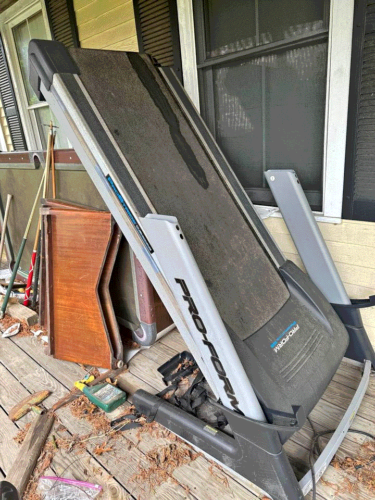 Before I started writing this post I did a search on Facebook Marketplace and found 276 used treadmills for sale with prices ranging anywhere from Free to $2,000.00.
Before I started writing this post I did a search on Facebook Marketplace and found 276 used treadmills for sale with prices ranging anywhere from Free to $2,000.00.
Care must be taken not to simply end up with someone else’s problem. I would recommend staying away from treadmills that look old and worn out. I would also stay away from commercial treadmills. While these can last a long time and give you years of problem-free service, should something go wrong you may have a hard time finding someone dependable locally to provide this service ( I do not service commercial treadmills) and the repair may be expensive.
Note: Nordictrack makes a model that they call “Commercial” but the are definitely not a commercial treadmill. Most commercial treadmills have AC drive motors and the decks do not fold up like most residential treadmills with few exceptions. Residential treadmills have DC drive motors.
How old is the treadmill? Residential treadmills typically have an average lifespan of 10-15 years. After that parts begin to become obsolete.
Look for well known brands such as Sole, Nordictrack, ProForm, etc. Then I would look for treadmills that are late model and look fairly new. Sometimes people buy a new treadmill with the intention of getting in shape and they even start. But soon after it just ends up as a coat rack folded up with the corner. Now they may be just looking for get rid of it, which may be a good deal for you.
When inspecting the treadmill does it look fairly new in spite of any dust that may have accumulated? Does the treadbelt look worn with two foot wear paths going down the belt?
Slide your hand under the treadbelt and feel the deck surface. Does it feel slick and smooth all the way across, or does it feel rough with wear grooves in the walking area? Do you feel any cracks that may indicate a broken deck? If the deck has any of these issues be prepared to purchase and install a new deck and treadbelt.
Is the treadmill still fully assembled and located where it can be plugged in and tested? I would not recommend purchasing a treadmill that is disassembled and/or cannot be tested out.
When the treadmill is powered on test to make sure that all of the buttons work. Typically they will beep even before you start running the treadmill. Does the incline go all the way up and down?
When running the treadmill stomp down on the treadbelt while running the treadmill at about 2 m.p.h. Does the belt stop, or feel like something is slipping? If so this could be a loose treadbelt or a loose drive belt.
I also like to see at least 2 ½” diameter rollers. These last longer,and put less stress on the belts and drive motor. Treadmills like some ProForms etc, have smaller motors and often small rollers. These may be okay for users that just want to walk, but I would opt for a Nordictrack or a Sole if running is the goal.
Next try it out. Do you hear any grinding indicating worn out bearings in the roller or motor? A loud whining noise may indicate bad motor bearings.
Does the incline go up and down? If this is all good. Then you may be good.
Think about the moving process. Do you have a pickup or know someone that can deliver it for you?
Think about where it is in their home and where it needs to go in yours. Most treadmills, even though they may fold up, need to be disassembled to be able to get them through doorways.
I do not recommend disassembly and reassembly by someone that does not know what they are doing. I have gone behind professional moving companies on many occasions to find a damaged treadmill. I offer this service on both ends for $129.00 at each end. Perhaps this is something else to calculate when negotiating the price.
Do you have a couple of strong people? for the move? At 74 years old I no longer offer that service.
![]()
